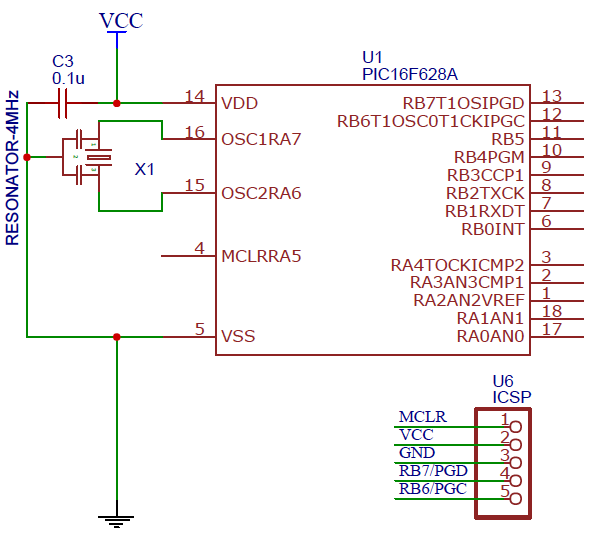Pic16f628a Programmer Circuit

The most popular PIC programmers (e.g. JDM, Tait, Microchip AN589 programmer,. PIC circuit for usage with LVISP programmer. To be able to use the LVISP.
Programmable relays find use in numerous automation applications such as automatic street light control, watering and pump control, HVAC, home automation, power plants automation in industries, etc. This article describes how to build a fully functional, one-channel programmable relay switch using the PIC16F628A microcontroller. It allows you to set both ON and OFF time. The maximum time interval that you can set for on and off operations is 99 hours and 59 minutes. Another interesting feature of this project is it offers cyclic option, which means you can choose to run it in a continuous loop of ON and OFF cycles. The device can be programmed through 4 push switches.
The programming menu and device status are displayed on a 16×2 character LCD. The timing resolution of this relay timer is 1 minute. The timer also saves the user inputs to its internal EEPROM so that it can retain these values after any power supply interrupt. Here are the summary of the features that this timer device has: • Microcontroller powered timer switch • OFF and ON time setup for the relay operation • Option for cyclic run • ON/OFF timing range: 0 to 99 hours and 59 minutes • 1 minute timing resolution • Interactive user interface using 4 tact switches and a character LCD • Buzzer alarm • On-board +5V voltage regulator Circuit diagram The hardware part of this project is very simple. Buku agama islam perguruan tinggi pdf.
The entire circuit runs off a regulated 5V power supply derived using the popular LM7805 linear regulator chip (Figure 1). To minimize the heat dissipation in the voltage regulator, the recommended input DC voltage to LM7805 is 9V, which can be easily obtained from a DC wall adapter. Diode D1 (1N4001) is used for reverse polarity protection in the circuit. S1 is a slide switch for turning the power supply on and off.
It was hosted by Marosnet enterprise network, Shared hosting and others. Over the time it has been ranked as high as 6 096 599 in the world, while most of its traffic comes from Russian Federation, where it reached as high as 479 447 position. Chertezhi modelej parusnikov iz dereva. Iz-dereva has the lowest Google pagerank and bad results in terms of Yandex topical citation index.

Figure 2 depicts the input and output setup. There are five tact switches in this project: one for microcontroller reset, and four for user inputs.
The four input switches are named as Menu/+, Select, Enter, and Start/Stop. Their functions will be described in the software section. The status of the 4 input switches is read by the PIC16F628A microcontroller through ports RA2, RA3, RA4, and RB0. The output LCD is a standard HD44780-based display and is driven in 4-bit mode. The pin assignments for the LCD data and control signals are shown in Figure 2. S2 is another slide switch that allows manual control of the LCD backlight. The output relay switch is driven through a NPN transistor (2N2222).
The project also includes a DC buzzer that beeps when the relay switch changes its status. The relay and buzzer circuits are shown in Figure 3.
The PIC16F628A microcontroller runs at 4.0 MHz using an external resonator. The I/O pins of PIC16F628A, the resonator connection, and the in-circuit serial programmer (ICSP) header are shown in Figure 4. Regulated +5V power supply unit Figure 2. I/O circuit with PIC16F628A pin assignments Figure 3. Relay and buzzer control circuit Figure 4. PIC16F628A resonator and ICSP header connections The PIC16F628A pin assignments for the LCD, switches, relay and buzzer circuits are listed in the following table. The following figure shows the complete relay timer circuit soldered on a general-purpose prototyping board.
Software The programmable relay timer gets inputs from the 4 push buttons. Their functions are described as follows: Menu/+: This button allows you to navigate between various menu options such as ON time setup, OFF time setup, and Cyclic option setup.
These options are displayed on the LCD. This button also serves as digit increment during time setup. The time is set in HH:MM format, which gives the minimum value of timing interval to be 1 min. Select: This allows you to choose a displayed menu option as well as individual hour and minute digits. The selected digit is incremented by 1 when Menu/+ button is pressed. Enter: When the appropriate hour and minutes are set, pressing the Enter button finalizes the time. The Cyclic option is also entered using this button.
Start/Stop: This push button is to start and stop the timer. If the timer is already on, you can stop it at anytime during its operation by pressing this button. Now let’s see how it works. Suppose, the relay switch is needed to be turned on after 15 minutes for 10 minutes. This means the OFF time is 15 minutes and ON time is 10 minutes. Once the timer is started after entering the above times, the device will be turned on after 15 minutes and remained on for 20 minutes.
- четверг 24 января
- 30